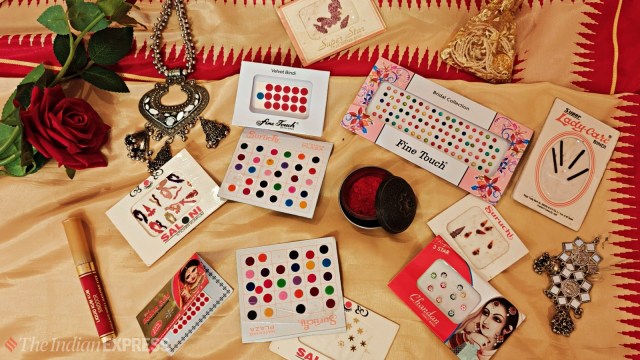📣 For more lifestyle news, click here to join our WhatsApp Channel and also follow us on Instagram
Can wearing cheap adhesive bindi cause leukoderma in the long run? Dermatologist answers
Adhesive bindis contain toxic chemicals that damage skin pigment and increase the risk of leukoderma over time.
 Unlike traditional bindis, most of the modern ones today are mere patches of fabric or plastic glued with chemical-ladden adhesives (Express Photo: Vaibhavi Mishra)
Unlike traditional bindis, most of the modern ones today are mere patches of fabric or plastic glued with chemical-ladden adhesives (Express Photo: Vaibhavi Mishra)Visit any market or fashion e-commerce website, and you’ll find plenty of designer bindis on display: minimalist, gaudy, pearl-studded, wavy… well, the list is endless. These are available in all shapes, sizes, colours, and patterns. However, this omnipresent fast fashion choice often comes with overlooked consequences: These artificial bindis can be harmful to the skin in the long run, leading to what dermatologists call bindi leukoderma.
Today, most are patches of fabric or plastic glued with adhesives containing p-tertiary butyl phenol (PTBP).
From fashion to infection
“Several published studies describe bindi leukoderma as contact depigmentation caused by melanocytotoxic chemicals present in bindi adhesives,” explains Dr Geetika Srivastava, dermatologist and founder of Delhi’s Influennz Clinic.
To put it straight, the point on the forehead where you apply these regularly starts losing pigment over time, giving a vitiligo-like appearance. This happens because of the notorious chemical p-tertiary butyl phenol (PTBP) used in making bindi adhesives. It is highly toxic to the cells responsible for producing skin pigment and can “trigger permanent depigmentation at the site of contact.”
The risks are even higher in hot, humid climates like India — where the bindi is traditionally worn — because it increases chemical penetration into the skin. Individual sensitisation and duration of exposure also play roles. “The longer you wear the adhesive bindi, the higher the risk of developing the condition,” says Dr Srivastava.
 Over time, bindis have evolved from simple kumkum dots to decorative stick-ons made with felt, velvet, glitter, or even stones (Express Photo: Vaibhavi Mishra)
Over time, bindis have evolved from simple kumkum dots to decorative stick-ons made with felt, velvet, glitter, or even stones (Express Photo: Vaibhavi Mishra)
Precaution is better than cure
Suggesting homemade bindis as a safe aletrnative, the expert said: “Restrict self-adhesive bindis to occasional use only.”
If you have sensitive skin, extra caution is essential. “People with a history of skin allergies or previous reactions to market bindis should stick to kumkum or homemade versions. Even sindoor, which may contain azo dyes, can cause leukoderma in sensitive individuals.”
However, prolonged use doesn’t immediately cause advanced damage. Dr Srivastava points out, “Several studies suggest that three out of four women develop an allergic reaction before the actual depigmentation sets in. If one discontinues usage at this stage, leukoderma can often be prevented.”
Is homemade bindi a solution?
Dr. Srivastava wholeheartedly agrees that organic kumkum remains the safest option. “Traditionally, bindis were made from kumkum, vegetable, or mineral dyes, and did not contain harmful chemicals. There was no risk of depigmentation.”
Alternatively, you can make your own kumkum at home using turmeric. “At worst, it may leave a temporary yellowish tint, but this is not harmful.”
However, she advises caution with ingredients like ghee and lime. “For some skin types, lime can cause alkaline burns, post-inflammatory hyperpigmentation, or trigger irritant contact dermatitis. Similarly, ghee may clog pores and trigger acne flare-ups in acne-prone skin. A small patch test goes a long way in such cases.”
DISCLAIMER: This article is based on information from the public domain and/or the experts we spoke to. Always consult your health practitioner before starting any routine.
📣 For more lifestyle news, click here to join our WhatsApp Channel and also follow us on Instagram
- 01
- 02
- 03
- 04
- 05



























